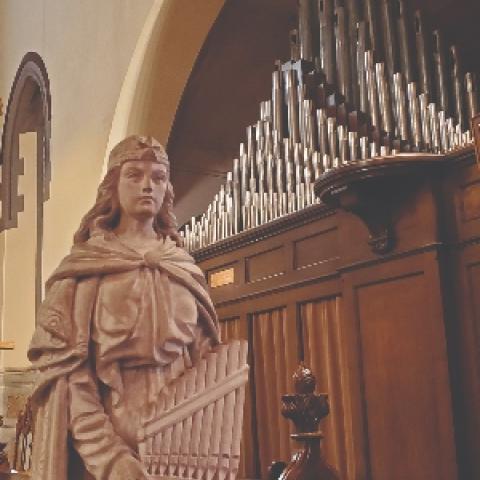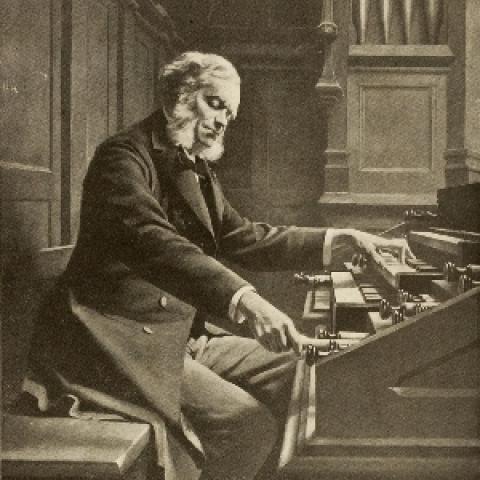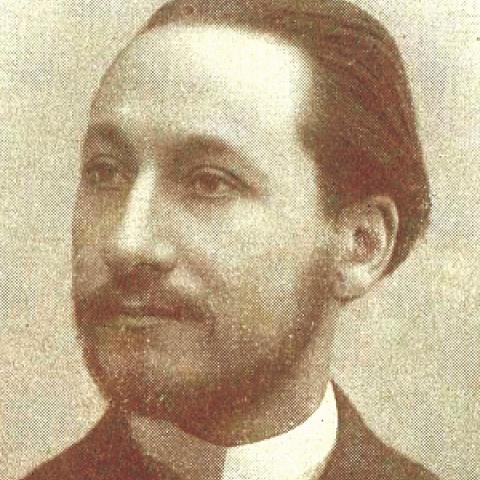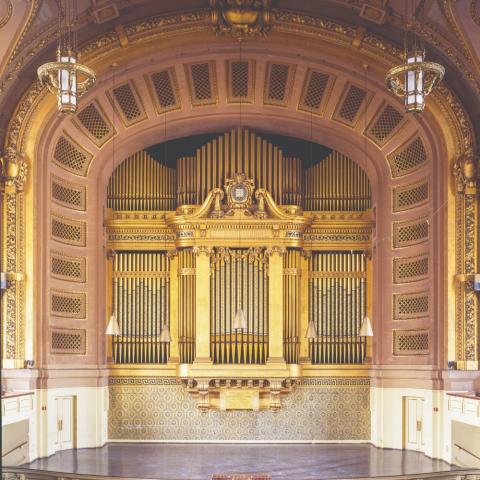Shelby Fisher earned Bachelor of Music and Master of Music degrees in organ performance and pedagogy from the University of Utah, Salt Lake City, where she studied under Kenneth Udy. She is organist and director of music at Christ United Methodist Church in Salt Lake City, Utah.

Jean Langlais (1907–1991) composed his organ Mass Suite médiévale in 1947, drawing on a rich tradition of French organ suites composed for use during the “low” Mass. Changes to the liturgy after the Second Vatican Council (“Vatican II”) in 1962 drastically reduced the role of the organ during the Mass, thereby eliminating the need for the French organ Mass. Suite médiévale is one example of a body of small-scale liturgical organ compositions that no longer carry their intended relevance due to changes to the liturgy. These works are often neglected in both concert and liturgical settings, yet they can be appropriate for both. Exploring the musical and liturgical heritage that influenced Langlais, as well as the changes resulting from the Second Vatican Council, provides today’s organists with a frame of reference to interpret and understand his organ compositions.
Organ music and the liturgy in twentieth-century France
During the four centuries between the Council of Trent in 1563 and the Second Vatican Council between 1962 and 1965, liturgical organ playing in France became highly developed in large part due to the autonomy afforded French bishops to govern the liturgy within each diocese.
The most widely known liturgy used in France was the Parisian Rite, which was used until the middle of the nineteenth century. Accordingly, most French liturgical organ music from the seventeenth to nineteenth centuries was written for the Parisian Rite.1 Eventually the Parisian Rite was supplanted by the more universally recognized Roman Rite. This affected the evolution of the French organ Mass in at least two ways. First was the retention of the “low Mass,” during which the organist played for virtually the entire service, pausing only for the reading and homily as described by Gaston Litaize:
During this era, the organist at the main organ normally played two Sunday Masses:
1) The “Grand Messe,” which involved a processional, an offertory, often an elevation, a communion, and a postlude; in addition, he alternated with the choir for verses of plainchant for the Ordinary (Kyrie, Gloria, Sanctus, Agnus Dei); they sang a verse and the organ commented on in, changing registrations for each verset.
2) The “Messe Basse,” where the organist could virtually play a recital. With everything spoken in a low voice [“à voix basse,” hence “Messe basse”], this is what happened: the priest left the sacristy, the organist played a procession, which lasted until the Gospel reading, then came the sermon. The organ then resumed and didn’t stop until there was no one left in the church. So, one could easily play a complete Choral by Franck.2
Second, with the introduction of the Roman Rite, French organists largely moved away from chant-based organ music, favoring all-purpose Offertoires or Grand Choeurs.
A chant revival movement soon made its mark on French liturgical organ music. In 1889, the Benedictine Abbey of Solesmes published a new chantbook based on extensive research of early manuscripts that sought to restore chant to its medieval form.3 Interest in chant revival trickled into Parisian music circles, where in 1894, organist-composers Alexandre Guilmant and Vincent D’Indy founded the Schola Cantorum de Paris. The school’s founding manifesto called for the “performance of plainchant according to the Gregorian tradition; restoration of polyphonic music in the Catholic Reformation style of Palestrina; the creation of ‘new modern Catholic music;’ and improvement of the repertory for organists.”4 Guilmant in particular championed a return to organ compositions that used chant, writing that, “The German organists have composed some pieces based on the melody of chorales, forming a literature for the organ that is particularly rich; why should we not do the same with our Catholic melodies?”5
No French organist-composer produced more of this literature than Charles Tournemire. He studied at the Paris Conservatory with César Franck and Charles-Marie Widor, eventually succeeding Franck as titular organist of Sainte Clotilde in 1898. His largest organ work was L’Orgue mystique, a cycle of 51 organ Masses, one for nearly every Sunday of the liturgical year. Each Mass comprises five movements: Prélude à l’Introït, Offertoire, Élévation, Communion, and Pièce terminale, all drawing motivic material from the proper chants for the given day.6
Jean Langlais and Suite médiévale
Charles Tournemire mentored only a few private students who showed the greatest promise. One of these students was Jean Langlais. Earlier Langlais had studied organ with André Marchal at the National Institute for Blind Students, then with Marcel Dupré at the Paris Conservatory. Upon graduation from the conservatory, Langlais continued improvisation studies with Tournemire and served as his assistant at Sainte Clotilde. Langlais chose Tournemire as his instructor specifically for Tournemire’s fluency with improvisation on plainchant.7
Langlais eventually succeeded Tournemire as organist at Sainte Clotilde in 1945. The Cavaillé-Coll organ at Sainte Clotilde had been enlarged and slightly modified at the end of Tournemire’s tenure, and Langlais was eager to compose for the new instrument. Langlais composed four organ Masses between 1947 and 1951.8 His Masses are important not only because they demonstrate both the pervasiveness of the plainchant revival movement and the development of the French School of improvisation and composition, but they are also significant because they are some of the last French organ Masses to be published.9
In 1947, Langlais completed Suite médiévale: en forme de messe basse.10 As indicated by the subtitle, the suite was intended for use at the “low” Mass. Langlais not only followed the same five-part structure as Tournemire, but also used chant as inspiration. However, unlike Tournemire’s L’Orgue mystique, Langlais chose chants appropriate for use throughout the liturgical year rather than those tied to a specific day.
The first movement of the suite is titled “Prélude: Entrée” and can be divided into two parts. The first half opens on full organ with a succession of parallel fourths and fifths suggestive of Notre-Dame organum followed briefly by the incipit to the chant “Asperges me, Domine,” or “Thou shalt sprinkle me, oh Lord,” before returning to the fortissimo parallel fourths and fifths. The antiphon, taken from Psalm 51, typically accompanied the Asperges, or ritual sprinkling of the congregation with holy water at the principal Mass on Sunday. The first half ends with the rubric, “If not needed, do not play further,” suggesting the flexibility of the suite to be adjusted to fit requirements of the Mass at the moment of performance. The second half further develops the chant, first in parallel fifths, and then in parallel fifths doubled at the octave in the manuals. In a nod to the Solesmes style of chant singing with its unpredictable pulse, the time signature throughout the “Prélude” changes frequently.
The second movement, “Tiento: Offertoire,” was intended for use during the offertory of the Mass, hence its longer performance length of four minutes. Here Langlais honors Spanish keyboard music of the sixteenth and seventeenth centuries, constructing a loosely imitative four-voice fugato, punctuated three times in the pedal by the Kyrie trope “Fons bonitatis” from Mass II. The Medieval practice of chant troping, or the insertion of additional texts and/or melodies within the standard chant, had long been abandoned. Langlais’ inclusion of the Kyrie trope is a clever acknowledgment of this historical practice rather than a modern application of chant. The movement ends with a final appearance of the chant accompanied by soft, homophonic chords. In order to keep rhythmic freedom without frequently changing the time signature, Langlais indicated “0” as the beginning time signature, explaining, “The sign 0 signifies free measures as for their length but regular as for their note value.” Langlais continued to employ this practice in later compositions.11
“Improvisation: Élévation” is the calm and meditative third movement, utilizing a simple registration of only a single stop for each manual. It begins in A major, then moves to E-flat Mixolydian just before the introduction of the well-known and ancient Eucharistic hymn “Adoro te.” The final four measures are in E major, a key favored by Frescobaldi and other sixteenth-century composers for use during elevation toccatas.12 The key of E and its cousin, the Phrygian mode, were traditionally used to express the mystical. The elevation represents the high point of the Mass at which time the celebrant elevates the host and chalice, having been transformed into the body and blood of Christ, so they may be adored by the congregation.13
The fourth movement, “Méditation: Communion,” was intended to be played as the congregation receives communion. It is based on two chants: “Ubi caritas,” an antiphon traditionally sung during the washing of the feet on Holy Thursday, but also appropriate as a Eucharistic hymn; and a second Eucharistic hymn, “Jesu dulcis memoria.” Langlais unifies the emergence of these themes with a sixteenth-note motive in multiple keys.
“Acclamations: Sur le texte des acclamations Carolingiennes” is the dramatic postlude of the suite. Langlais uses fragments of the ancient Roman chant “Laudes Regiae” from the Carolingian Acclamations, a hymn historically sung at solemn occasions and adopted by the Holy Roman Emperor, Charlemagne. The melody for the words “Christus vincit” repeats six times in the pedal in alternation with the phrase “Exaudi Christi” from the same chant. Langlais adds two more chant fragments, “Christus regnat” and “Christus imperat,” and repeats them employing an ascending harmonic pattern he often used to create tension. Similarly, the manuals play the “Christus vincit” theme first in F, then in G, and finally in A, to which the pedal responds with “Christus imperat” first in F, then F-sharp and then G. Langlais concludes by introducing a pedal carillon of C–F–G–D played in long notes against the “Christus vincit” theme stated in manual octaves. Marie-Louise Langlais notes that these final measures are reminiscent of the bells of Reims Cathedral, where French kings were crowned during the Medieval period.14
Langlais’ reaction to the Second Vatican Council
As early as 1900, French clergy began holding grassroots meetings to study the Church’s handling of religious expression, particularly with regard to participation of the congregation at Mass.15 By 1945 this populist movement became known as Catholic Action, and its followers known as the “new liturgists.”16 At the heart of the new liturgists’ agenda was the democratization of the liturgy brought about partly through changing the musical context of the Mass. Other clergy and most professional musicians saw the new liturgists as a threat to the traditional practice of church music. The new liturgists championed simple, approachable music that favored congregational singing and the use of the vernacular rather than Latin. Furthermore, many in favor of liturgical reform sought to also diminish the role of both the organ and chant.
Langlais was distraught by the changes the new liturgists brought to the Mass. He regarded these changes as a departure from the artistic mission of the Church and wrote:17
All religious composers, of which I am one, are deeply discouraged by this movement, which is the negation of art. In my opinion nothing is beautiful enough for God. Our forebears knew this and held that to pray surrounded by beauty was central to worship.
The new liturgist movement reached its peak during the Second Vatican Council. In December 1963, the council issued the Constitution on the Sacred Liturgy. Initially the constitution alleviated the concerns of the professional musicians by declaring the musical tradition of the Church as “a treasure of inestimable value, greater even than that of any other art.”18 While the council supported the use of Gregorian chant and polyphony, it also seemed to support the new liturgists by stating that “to promote active participation, the people should be encouraged to take part by means of acclamations, responses, psalms, antiphons, hymns as well as by actions, gestures, and bodily attitudes. And at the proper time a reverent silence should be observed.”19 In the practical application of the constitution, it was the new liturgists that seemed to gain the upper hand.
In 1962, Langlais and other organists served on the French Episcopal Commission on Sacred Music, tasked with interpreting the Second Vatican Council’s new guidelines on liturgical music. A second group, the Commission of Expert Musicians, was formed in 1964 to supply new music to accompany the Propers that had been newly translated into French.
The role of the organ was a troublesome point in the new liturgy. Monsignor Maurice Rigaud, who acted as president of both the French Episcopal Commission on Sacred Music and the Commission of Expert Musicians, indicated that silence was to replace the use of the organ after the collect, at the offertory, at the elevation, and at communion; and in addition, that sung chant rather than the organ was the preferred method of balancing music with silence. The organists serving on both commissions lamented to Rigaud that there was nothing left for the organists to do during the Mass:20
If the role of the organist is so reduced to this sort of humming in the background, in this role of “hole-filling” between two verses of songs in French and to serve as accompaniment for eventual new songs, one wonders . . . if it is now necessary to train young organists and to place them in careers that are reduced to such a farce, a career that is so long in its preparation, so costly, so laborious and difficult. One no longer even sees the necessity to maintain organ classes in our Conservatories and Schools of Music.
Musically, Langlais was slow to respond to Vatican II. Though initially supportive of attempts to write music for the new liturgy, Langlais became discouraged not only with the Commission of Expert Musicians’ tendency to favor the opinions of clergy over those of professional musicians but also with the low quality of new music that was admitted. In an interview with L’Est Républicain, Langlais was bold in his opinion of this new music, saying, “The goal of those who are currently writing religious songs is good, but the quality of the music is mediocre.”21
Langlais’ shameless musical response to Vatican II was his Trois Implorations, commissioned as the final organ exam piece at the Paris Conservatory in the spring of 1970. The third movement of the set, “Imploration pour la croyance,” expresses Langlais’ continued frustration with the Catholic Church. In his program notes Langlais writes, “The composer has tried to translate the state of the soul of a Christian in revolt against the current desacralizing atmosphere.”22 Langlais uses the chant intonation of the Credo from Masses I, II, and IV “Credo in unum Deum,” answered by staccato chord clusters with full organ as if in protest. The juxtaposition of chant and chord clusters continues until the piece finally ends with five staccato chords that use all twelve tones of the scale simultaneously. Marie-Louise Langlais writes that “Imploration pour la croyance” is Langlais’ way of shouting to the world, “I believe with all my strength, but with all my strength I also suffer from what I hear in the Church.”23
Conclusion
Langlais represents the culmination of the Sainte Clotilde organist-composer tradition, which began with César Franck and continued with Charles Tournemire. His style represents a unique synthesis of twentieth-century compositional techniques, traditional influences, and theological commentary. His close personal and professional ties to the Catholic Church at a time when it was experiencing major changes significantly influenced his work.
One cannot understand Langlais’ music without considering his Catholicism. To appreciate Langlais’ “other-worldly” harmonies and diverse colors, it is important to understand the religious context that inspired his compositions. Langlais saw himself not just as a composer, but also as a theologian, whose role was to connect the faithful to God. Although Vatican II reforms have erased its original context, Suite médiévale remains an excellent representation of Langlais’ compositional style and techniques; with short movements, contrasting tone colors, and recognizable chant fragments, it is an exciting and convincing work that merits continued recognition in the organ repertory.
Notes
1. Orhpa Ochse, Organists and Organ Playing in Nineteenth-Century France and Belgium (Bloomington, Indiana: Indiana University Press, 1994), 127.
2. Marie-Louise Langlais, Jean Langlais Remembered (New York: American Guild of Organists, 2016), 136–137.
3. Stephen Schloesser, Jazz Age Catholicism: Mystic Modernism in Postwar Paris, 1919–1933 (Toronto: University of Toronto Press, 2005), 284.
4. Ibid.
5. Edward Zimmerman and Lawrence Archbold, “Why Should We Not Do the Same with Our Catholic Melodies?: Guilmant’s L’Organiste liturgiste, Op. 65,” in French Organ Music from the Revolution to Franck and Widor, ed. Lawrence Archbold and Willliam J. Peterson (New York: University of Rochester Press, 1995), 203.
6. Edward Schaefer, “Tournemire’s L’Orgue mystique and Its Place in the Legacy of the Organ Mass,” in Mystic Modern: The Music, Thought, and Legacy of Charles Tournemire, ed. Jennifer Donalsen and Stephen Schloesser (Richmond, Virginia: Church Music Association of America, 2014), 40.
7. Langlais, Jean Langlais Remembered, 41.
8. Langlais published Suite brève and Suite médiévale in 1947, Suite française in 1948, and Hommage à Frescobaldi in 1951.
9. Schaefer, 31.
10. Langlais, Langlais Remembered, 133.
11. Langlais, Langlais Remembered, 145.
12. Willi Appel, The History of Keyboard Music to 1700 (Bloomington, Indiana: Indiana University Press, 1972), 478.
13. John Caldwell and Bonnie J. Blackburn, “Elevation,” In Grove Music Online (Oxford University Press, 2001).
14. Langlais, Langlais Remembered, 138.
15. Ann Labounsky, Jean Langlais: The Man and his Music (Portland, Oregon: Amadeus Press, 2000), 211.
16. Labounsky, 211.
17. Labounsky, 214.
18. Anthony Ruff, Sacred Music and Liturgical Reform: Transformations and Treasures (Chicago, Hillenbrand Books, 2007), 314.
19. Labounsky, 219.
20. Labounsky, 226.
21. Labounsky, 229.
22. Labounsky, 272.
23. Langlais, Jean Langlais Remembered, 263.
Bibliography
Apel, Willi. The History of Keyboard Music to 1700. Bloomington, Indiana: Indiana University Press, 1972.
Archbold, Lawrence and Edward Zimmerman, “Why Should We Not Do the Same with Our Catholic Melodies?: Guilmant’s L’Organiste liturgiste, Op. 65,” in French Organ Music from the Revolution to Franck and Widor, ed. Lawrence Archbold and William J. Peterson. Rochester, New York: University of Rochester Press, 1995.
Caldwell, John and Bonnie J. Blackburn. “Elevation,” Grove Music Online, Oxford Music Online, http://www.oxfordmusiconline/ezproxy/lib/utah.edu/grovemusic/view/10.1093/gmo/9781561592630.0001/omo-9781561592630-e-0000023373 (accessed March 22, 2019).
Darasse, Xavier, and Marie-Louise Jaquet-Langlais. “Jean Langlais,” Grove Music Online, Oxford Music Online, http://www.oxfordmusiconline.com/ezproxy.lib.utah.edu/grovemusic/view/10.1093/gmo/9781561592630.001.0001/omo-9781561592630-e-0000023373 (accessed March 22, 2019).
Donelson, Jennifer, and Stephen Schloesser, ed. Mystic Modern: The Music, Thought and Legacy of Charles Tournemire. Richmond, Virginia: Church Music Association of America, 2014.
Labounsky, Ann. Jean Langlais: The Man and His Music. Portland, Oregon: Amadeus Press, 2000.
Langlais, Jean. Suite médiévale en forme de messe basse. Paris: Éditions Salabert, 1950 (originally published 1947).
Langlais, Marie-Louise. Jean Langlais Remembered, trans. Bruce Gustafson. New York: American Guild of Organists, 2016.
Mahrt, Peter William. The Musical Shape of the Liturgy. Richmond, Virginia: Church Music Association of America, 2012.
Ochse, Orpha. Organists and Organ Playing in Nineteenth-Century France and Belgium. Bloomington, Indiana: Indiana University Press, 1994.
Piunno, John. “Restoring Liturgy and Sacred Music in the Latin Roman Rite.” The American Organist 135, 4 (2010): 82–85.
Poterack, Kurt. “Vatican II and Sacred Music.” Sacred Music 125, 4 (1998): 5–19.
Rone, Vincent. “A Voice Cries Out in the Wilderness: The French Organ School Responds to the Second Vatican Council of the Catholic Church.” PhD diss., University of California, 2014.
Ruff, Anthony. Sacred Music and Liturgical Reform: Treasures and Transformations. Chicago, Illinois: Hillenbrand Books, 2017.
Schloesser, Stephen. Jazz Age Catholicism: Mystic Modernism in Postwar Paris, 1919–1933. Toronto: University of Toronto Press, 2005.
The Parish Book of Chant. Richmond, Virginia: Church Music Association of America, 2008.







